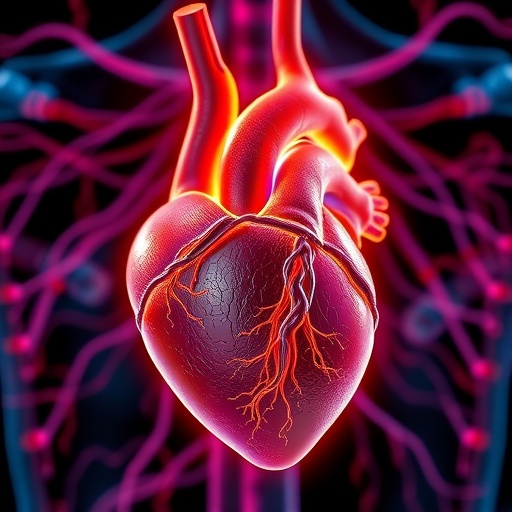hPKM2 Boosts Heart Recovery Post-Myocardial Infarction – BIOENGINEER.ORG

Report on a Novel Therapeutic Strategy for Post-Infarction Heart Failure and its Alignment with Sustainable Development Goals
Introduction: Advancing SDG 3 Through Cardiovascular Innovation
A recent study presents a significant advancement in cardiovascular medicine, directly contributing to the United Nations Sustainable Development Goal 3 (SDG 3), which aims to ensure healthy lives and promote well-being for all at all ages. Research conducted by Sun, Wu, Adjmi, et al., demonstrates that transient overexpression of the human pyruvate kinase M2 (hPKM2) enzyme in cardiomyocytes can prevent the progression to heart failure following a myocardial infarction (MI). This metabolic intervention addresses a leading cause of global mortality and aligns with SDG Target 3.4, which seeks to reduce premature mortality from non-communicable diseases (NCDs) like heart disease.
Core Research Findings
Subject of Investigation
- Condition: Heart failure following myocardial infarction.
- Therapeutic Target: The glycolytic enzyme human pyruvate kinase M2 (hPKM2).
- Mechanism: Targeted, transient gene overexpression to modulate cardiomyocyte metabolism.
- Model: A clinically relevant porcine model, which closely mimics human cardiac physiology.
Key Outcomes
- Animals treated with hPKM2 overexpression demonstrated significantly improved cardiac function.
- The intervention led to increased survival of cardiomyocytes and attenuated fibrotic remodeling.
- Metabolic reprogramming shifted cardiomyocytes toward an anabolic state conducive to cellular repair and survival.
- The therapy exhibited anti-inflammatory effects, reducing pro-inflammatory signaling and macrophage infiltration, which further supports cardiac recovery.
Contribution to Sustainable Development Goals (SDGs)
SDG 3: Good Health and Well-being
This research provides a direct and powerful contribution to achieving global health targets by addressing ischemic heart disease, a primary NCD.
- Reducing Premature Mortality (Target 3.4): By offering a novel method to prevent heart failure, the study presents a potential pathway to decrease mortality rates associated with myocardial infarction.
- Promoting Health and Well-being: An effective therapy that rescues the myocardium and preserves cardiac function would substantially improve the quality of life for millions of heart attack survivors, preventing the debilitating effects of chronic heart failure.
- Advancing Medical Treatment: The study pioneers a new therapeutic class focused on metabolic modulation, moving beyond conventional symptom management to actively promote cellular rescue and repair.
SDG 9: Industry, Innovation, and Infrastructure
The study exemplifies the principles of SDG 9 by fostering scientific innovation and building a foundation for new health technologies.
- Enhancing Scientific Research (Target 9.5): The research represents a breakthrough in the fusion of metabolic biology, gene therapy, and cardiac medicine, pushing the boundaries of current scientific knowledge.
- Technological Advancement: The development of a transient gene expression system highlights innovation in precision medicine, enhancing safety and therapeutic efficacy while minimizing long-term risks associated with permanent genetic modification.
- Translational Potential: The successful use of a large animal model bridges a critical gap between laboratory research and human clinical trials, accelerating the potential for this innovation to reach the public and create new biotechnological applications.
Mechanistic Insights and Therapeutic Strategy
Dual Functionality of hPKM2
The therapeutic efficacy of hPKM2 stems from its dual roles in cellular processes:
- Metabolic Regulation: It enhances glycolytic flux to supply intermediates for biosynthetic pathways essential for antioxidant defense and cellular repair.
- Gene Regulation: Its non-metabolic functions contribute to regulating transcription factors that govern cardiac remodeling processes.
Key Molecular Pathways
The study identified that hPKM2 overexpression modulates critical signaling cascades that promote cell survival under ischemic stress, including:
- Activation of AMP-activated protein kinase (AMPK).
- Upregulation of hypoxia-inducible factor 1-alpha (HIF-1α).
- Reduction in apoptosis and preservation of mitochondrial function.
Conclusion and Future Outlook
The transient overexpression of hPKM2 in cardiomyocytes represents a landmark achievement in the pursuit of effective treatments for heart disease. This research provides a robust, pre-clinical proof-of-concept for a therapy that could prevent heart failure post-MI. By directly addressing a major global health challenge, this work strongly supports the ambitions of SDG 3. Furthermore, its innovative approach embodies the spirit of SDG 9, driving scientific progress with significant societal impact. Future efforts will focus on refining gene delivery methods and advancing this promising strategy toward human clinical trials, offering tangible hope for reducing the global burden of cardiovascular disease.
1. Which SDGs are addressed or connected to the issues highlighted in the article?
-
SDG 3: Good Health and Well-being
- The article directly addresses this goal by focusing on a “novel therapeutic strategy to combat heart failure,” which is described as “one of the leading causes of mortality worldwide.” The research aims to improve health outcomes for millions suffering from ischemic heart disease, contributing to the overall goal of ensuring healthy lives and promoting well-being.
-
SDG 9: Industry, Innovation, and Infrastructure
- This goal is relevant as the article showcases a “groundbreaking study” that represents a significant scientific innovation. The development of a “transient overexpression technique” using “targeted gene delivery vectors” exemplifies cutting-edge research and technological advancement in cardiovascular medicine. The article highlights this as a “paradigm shift” and a “clarion call for intensified efforts aimed at metabolic reprogramming,” which aligns with the goal of fostering innovation and enhancing scientific research.
2. What specific targets under those SDGs can be identified based on the article’s content?
-
Target 3.4: Reduce by one-third premature mortality from non-communicable diseases.
- The research presented in the article directly contributes to this target. Heart failure following myocardial infarction is a major non-communicable disease (NCD). The study’s objective is to develop a treatment that “mitigates the devastating progression toward heart failure” and “prevents heart failure post-myocardial infarction,” thereby aiming to reduce mortality from this specific cardiovascular condition.
-
Target 3.b: Support the research and development of vaccines and medicines for communicable and non-communicable diseases.
- The article is a clear example of progress toward this target. It details the research and development of a novel therapeutic intervention (“hPKM2 overexpression”) for heart disease, a prevalent NCD. The text describes a “promising intervention platform that might soon transition from the bench to bedside,” embodying the spirit of supporting R&D for new medicines and treatments.
-
Target 9.5: Enhance scientific research, upgrade the technological capabilities of industrial sectors in all countries… encouraging innovation.
- The study exemplifies the enhancement of scientific research. It is described as an “innovation” that “heralds a new era where enzyme modulation may be harnessed to rebuild a failing heart.” The development and successful application of a sophisticated gene therapy technique in a large animal model that “closely mimics human cardiac physiology” directly contributes to upgrading technological capabilities in the biomedical sector.
3. Are there any indicators mentioned or implied in the article that can be used to measure progress towards the identified targets?
-
Mortality Rate from Cardiovascular Disease (Implied for Target 3.4)
- The article states that “Heart failure remains one of the leading causes of mortality worldwide.” The ultimate success of the described therapy would be measured by a reduction in this mortality rate. The study provides proxy indicators of this, such as “increased survival of cardiomyocytes” and “significantly improved cardiac function” in the treated porcine models.
-
Development of New Medical Treatments and Technologies (Implied for Targets 3.b and 9.5)
- The article itself, published in *Nature Communications*, is an indicator of research output. The development of the “transient overexpression of hPKM2” as a therapeutic strategy is a tangible new technology. Progress can be measured by tracking the advancement of this strategy through the clinical trial pipeline, as the article notes that “the cardiology community eagerly anticipates clinical trial results.”
-
Clinical and Physiological Metrics of Cardiac Health (Mentioned for Target 3.4)
- The article explicitly mentions several indicators used to measure the therapy’s effectiveness, which can be used to track progress in treating heart disease. These include “echocardiographic and hemodynamic measurements,” “attenuated fibrotic remodeling,” “reduced apoptosis,” “sustained mitochondrial function,” and attenuated “pro-inflammatory signaling and macrophage infiltration.” These metrics provide quantifiable evidence of improved health outcomes.
4. Create a table with three columns titled ‘SDGs, Targets and Indicators” to present the findings from analyzing the article.
| SDGs | Targets | Indicators |
|---|---|---|
| SDG 3: Good Health and Well-being | 3.4: Reduce premature mortality from non-communicable diseases. |
|
| 3.b: Support the research and development of medicines for non-communicable diseases. |
|
|
| SDG 9: Industry, Innovation, and Infrastructure | 9.5: Enhance scientific research and encourage innovation. |
|
Source: bioengineer.org
What is Your Reaction?
 Like
0
Like
0
 Dislike
0
Dislike
0
 Love
0
Love
0
 Funny
0
Funny
0
 Angry
0
Angry
0
 Sad
0
Sad
0
 Wow
0
Wow
0




















































.jpg.webp?itok=0ZsAnae9#)

























